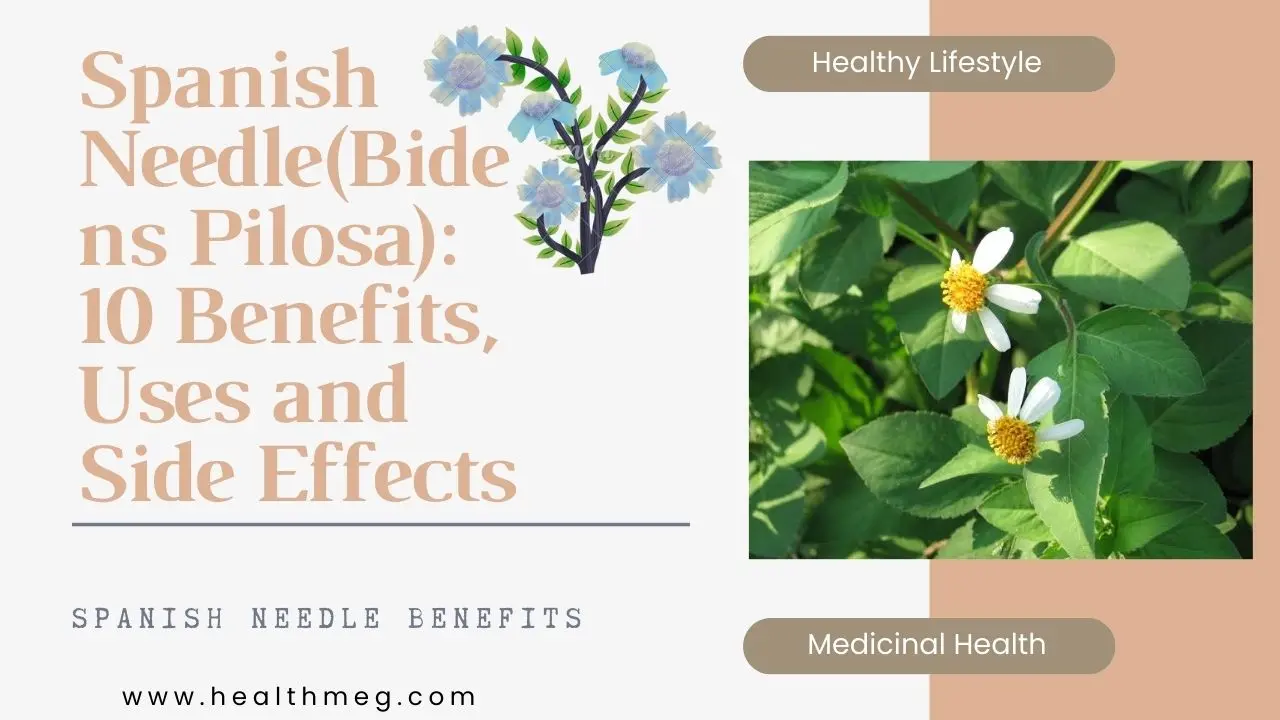Introduction
Spanish needle (Bidens pilosa) is an herbaceous plant native to South America that has been used in traditional medicine across the world. With its long history and widespread use, the Spanish needle provides a variety of potential health benefits that science is only beginning to uncover. This article explores the science-based uses and benefits of this impressive plant.
Let’s explore what is Spanish needle, its uses, 10 Spanish needle benefits, and side effects.
Do read the People Also Ask (FAQs) about this topic.
Key Takeaways:
- Spanish needle is a herbaceous plant with a long history of medicinal use for treating a wide range of health conditions.
- All parts of the plant, including the roots, leaves, seeds and flowers, contain beneficial bioactive compounds like polyphenols and flavonoids.
- Spanish needle demonstrates science-based benefits for immunity, inflammation, liver health, digestion, wound healing, diabetes, cognitive function, and cancer defence.
- Antioxidant, anti-inflammatory and antimicrobial properties contribute to many of the Spanish needle’s therapeutic effects.
- Animal studies and emerging human research support traditional medicinal uses of Spanish needles for diseases like infections, jaundice, dysentery and more.
- Preparations like tea, tincture, capsules and paste allow you to harness the health benefits of Spanish needles.
What is Spanish Needle?
Spanish needle, also referred to as cobbler’s pegs, is an annual, flowering plant that can grow over 6 feet tall. It has white petal flowers that develop into black, barbed fruits. The leaves are toothed and oval-shaped. This versatile plant grows well in disturbed areas and adapts to a variety of soils and climates.
While considered an invasive weed in some regions, the Spanish needle has an extensive history of medicinal and culinary use in places like Africa, Asia, South America, and the Southern United States. All parts of the plant, including the roots, leaves, and seeds have been used to treat a wide range of health conditions.
Science-Based Spanish Needle Benefits
With a long traditional history of use, what does modern science have to say about Spanish needles? An emerging body of research is now confirming many of the traditional uses of this herb and uncovering potential new benefits. Here are some of the top, evidence-based ways Spanish needles may support health:
- Rich in Antioxidants
- Boosts Immunity
- Anti-Inflammatory
- Antimicrobial
- Liver Health
- Digestive Aid
- Wound Healing
- Diabetes Support
- Neuroprotective
- Cancer Fighter
1. Rich in Antioxidants
Contains Antioxidants Spanish needle is rich in polyphenols, flavonoids, anthocyanins, and other antioxidant plant compounds. These antioxidants help counter oxidative stress from free radicals and inflammation in the body. The high antioxidant capacity contributes to the majority of the Spanish needle’s health benefits, from protecting the liver to reducing chronic disease risk.
2. Boosts Immunity
In multiple studies, extracts of Spanish needles have been shown to enhance immune activity. Specific compounds appear to stimulate white blood cell production and activation, enabling the body to mount a more effective immune response. This immune-boosting ability may partially explain why this herb has been traditionally used to prevent infections and treat inflammatory conditions.
3. Anti-Inflammatory
Anti-Inflammatory Effects Related to its immune-enhancing functions, the Spanish needle demonstrates natural anti-inflammatory activities. The flavonoids and other anti-inflammatory constituents reduce swelling, pain, and joint damage associated with inflammation. Using a Spanish needle long-term may help lower inflammation underlying chronic diseases.
4. Antimicrobial
Antimicrobial Properties From the roots to the leaves and seeds, all parts of the Spanish needle exhibit antimicrobial effects against certain bacteria, fungi, parasites, and viruses. Traditional use of the plant for infectious diseases correlates to these broad antimicrobial abilities. The antimicrobial functions likely contribute to the Spanish needle’s immune-strengthening benefits as well.
5. Liver Health
Supports Liver Health With antioxidant, anti-inflammatory and antimicrobial properties, the Spanish needle is also beneficial for protecting liver health. Animal studies indicate the herb protects liver tissue from chemical damage while also helping regenerate liver cells. Traditionally used for jaundice, the Spanish needle continues to demonstrate hepatoprotective effects according to modern analysis.
6. Digestive Aid
Aids Digestion Traditional medicine systems like Ayurveda have long used Spanish needles for digestive complaints like dysentery, indigestion, and constipation. As science now suggests, the anti-inflammatory, antimicrobial and analgesic properties of Spanish needles help normalize gut function and relieve discomfort associated with digestive issues.
7. Wound Healing
Wound Healing Topically applying Spanish needle extract helps accelerate wound closure while also protecting wounds from bacterial infection. Researchers suggest these wound healing benefits stem from enhanced tissue regeneration and antimicrobial activities. Using Spanish needles on cuts and burns aligns with the traditional topical use for skin healing.
8. Diabetes Support
Diabetes Support With inflammation being a key driver in insulin resistance and high blood sugar, the Spanish needle shows promise for diabetes management through its anti-inflammatory effects. Animal research also demonstrates the herb’s ability to help regulate blood sugar levels already within normal range while protecting pancreatic beta cells.
9. Neuroprotective
Neuroprotective Effects Oxidative damage and inflammation in the brain contribute to neurodegenerative diseases like Alzheimer’s. Potent antioxidant and anti-inflammatory herbs like Spanish needles help prevent this neural damage. Early studies also show the potential for Spanish needles to inhibit the formation of beta-amyloid plaques associated with cognitive decline.
10. Cancer Fighter
Cancer-Fighting Properties The Spanish needle exhibits selective toxicity towards numerous types of cancer cells while sparing healthy cells, according to emerging research. Specific compounds in the plant suppress tumour proliferation through a variety of proposed mechanisms, from triggering cancer cell apoptosis and inhibiting metastasis to enhancing the cancer-fighting effects of immune cells and conventional drug therapies. Though human trials are still needed, these preliminary cancer-suppressing abilities are promising.
As research continues to reveal beneficial bioactive compounds and validate traditional uses, the Spanish needle appears as a prime herb to support whole-body health, from immunity and digestion to liver function and chronic disease prevention.
How To Use Spanish Needle
For thousands of years, traditional healers worldwide have effectively used Spanish needles to treat various conditions. You can make the most of the Spanish needle’s healing properties by using the herb in these main preparations:
Tea – Pour hot water over fresh or dried leaves, flowers and roots to extract beneficial compounds into an herbal tea. Enjoy the infusion up to 3 times daily.
Tincture – Soaking the Spanish needle plant in alcohol for weeks yields a concentrated liquid extract that preserves the herb’s key constituents. For health maintenance, take 30-60 drops of tincture once or twice a day.
Capsule – Spanish needle capsules provide the most convenient option for getting supplemental doses of dried, powdered herbs. Follow package dosing or take approximately 500-1000mg daily.
Paste – Make a paste by grating or blending Spanish needle leaves and stems with a small amount of water. Apply this paste directly to wounds, burns or swollen joints to provide localized relief and healing.
Juice – Blend fresh Spanish needle leaves and stems with water then strain out the solids. Drink 1-2 ounces of this green juice daily to receive immediate nutrient benefits from the living plant compounds.
When ingesting Spanish needle supplements for an extended period or giving them to children, consult your doctor or functional medicine practitioner for guidance on ideal extract doses and schedules. Monitor your body’s response for maximum individual benefit.
Potential Side Effects
When used appropriately, Spanish needle tea, tinctures, capsules and external applications come with an exceptional safety profile and typically produce minimal side effects. Mild, temporary digestive upset has occasionally occurred with high doses taken orally. Due to its blood glucose-lowering effects, closely monitor blood sugar levels if taking a Spanish needle for diabetes.
Certain chemical constituents like thiophene derivatives found in Spanish needles may cause allergic reactions in some individuals. Discontinue use if any hypersensitivity symptoms develop. Pregnant or breastfeeding women should exercise caution with Spanish needles due to a lack of safety research for these populations.
A Versatile, Healing Weed
Weeds often get an unfair reputation as pesky plants that only serve to overtake ornamental gardens. However, weeds like Spanish needles demonstrate how prolific plants have much more to offer. Beyond its hardiness and adaptogenic growth habits, the Spanish needle overflows with health-promoting bioactive compounds that science is only now beginning to tap into.
With an amazing ability to thrive and spread while also generously producing antioxidants, antimicrobials and anti-inflammatories, the Spanish needle appears specially equipped to protect and heal the human body. Traditional cultures valued these gifts for centuries. Now modern applications of this versatile weed continue illuminating its therapeutic potential to fight disease, ease suffering and boost whole body wellness.
Conclusion
With extensive traditional use validated by modern science, the Spanish needle continues to display immense healing potential as a medicinal herb. Its versatility, safety and nutrient density make the Spanish needle an excellent option for maintaining whole-body wellness and overcoming chronic inflammation underlying many diseases. Though sometimes dismissed as an invasive weed, ongoing research continues to uncover the profound health-promoting value this resilient plant has provided for centuries across the globe.
People Also Ask (FAQs)
Q) What are Spanish needles good for?
A) Spanish needles have a wide range of traditional medicinal uses that modern research is now validating. All parts of the plant demonstrate benefits for immune health, reducing inflammation, fighting infections, supporting liver function and digestion, healing wounds, managing diabetes, protecting brain health, and destroying cancer cells.
Q) Is Spanish needles good for the eyes?
A) There is no research indicating any specific benefits or uses of Spanish needles for eye health or vision improvement. However, the antioxidant content may provide overall supportive effects by reducing oxidative damage linked to macular degeneration and other eye conditions.
Q) What are the characteristics of Spanish needles?
A) The Spanish needle is an annual, flowering plant that grows over 6 feet tall in disturbed areas adaptable to various soil types. It has white petal flowers that develop into black, barbed seed fruits. The leaves are oval with toothed edges. The roots, leaves, seeds and flowers all demonstrate medicinal value.
Q) Are Spanish needles edible?
A) Yes, the Spanish needle is considered edible and is consumed as a cooked green vegetable primarily in parts of Africa and Asia. However, reports of diarrhoea and gastrointestinal upset have been noted from eating improperly prepared plants or in excess. Moderate amounts of boiled, thoroughly cooked leaves may be safely ingested according to some sources.












